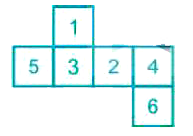There are 20 unit cubes all of whose faces are white, and 44 unit cubes all of whose faces are red.They are put together to form a bigger cube (4 x 4 x 4). What is the minimum number of white faces visible on this larger cube?
Step by step video & image solution for There are 20 unit cubes all of whose faces are white, and 44 unit cubes all of whose faces are red.They are put together to form a bigger cube (4 x 4 x 4). What is the minimum number of white faces visible on this larger cube? by Maths experts to help you in doubts & scoring excellent marks in Class 11 exams.
Updated on:21/07/2023Similar Questions
There are 20 unit cubes all of whose faces are white, and 44 unit cubes all of whose faces are red.They are put together to form a bigger cube (4 x 4 x 4). What is the minimum number of white faces visible on this larger cube?
View SolutionTwo cubes have their faces painted either red or blue. The first cube has five red faces and one blue face. When the two cubes are rolled simultaneously, the probability that the two top faces show the same colour is 1/2. Number of red faces on the second cube, is
View Solution
Knowledge Check
There are six faces in a cube . Rajeev fix one cube on each of the faces . The dimensions of all the cubes are same. What is the ratio of total surface area of the newly formed solid to the area of a single cube ?
A7:1B6:1C5:1D41:9There are six faces in a cube . Rajeev fix one cube on each of the faces . The dimensions of all the cubes are same. What is the ratio of total surface area of the newly formed solid to the area of a single cube ?
A7:1B6:1C5:1D41:9Three solid cubes have a face diagonal of 4√2 cm each. Three other solid cubes have a face diagonal of 8√2 cm each. All the cubes are melted together to form a cube. Find the side of the cube formed in cm).
A3√324B3√576C12D24
The faces of a red cube and a yellow cube are numbered from 1 to 6. Both cubes are rolled. What is the probability that the top face of each cube will have the same number?
View SolutionThe effective number of atoms per unit cell in a face centred cube and body centred cube are :
View SolutionThe number of atoms per unit cell in a face-centred cube is:
View SolutionA compound formed by elements X and Y has a cubic structure in whch X atoms are at the corner of the cube and also at the face centers. Y atoms are present at the body center and at the edge center of the cube.
If all the atoms from the diagonals of one of the face of the cube are removed, then Zeff is
View SolutionIf the following figure is folded to form a cube, then which number will be on the face opposite to the face having number '1'?

View Solution
